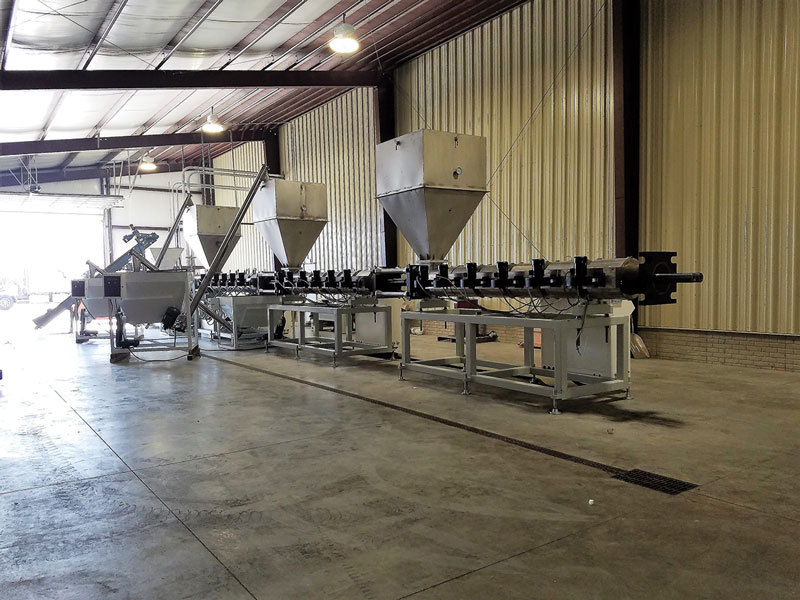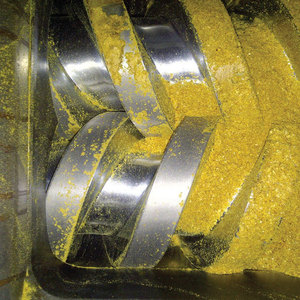Turning the Screws on Drying



PHOTO: RAYEMAN ELEMENTS
August 22, 2017
BY Susanne Retka Schill
Mike Thomas was working on pelletizing wet distillers grains when the steam escaping from the extruders he was using got him to thinking that with some modifications, he could dry the wet cake as well. Five years and $20 million later, he’s writing several proposals for ethanol plants looking at installing a Rayeman Compression Dryer.
Three sections of the dryer filling a corner of the exhibit hall at the International Fuel Ethanol Workshop & Expo in June in Minneapolis also sparked a lot of interest he’s now following up on. Shortly before the FEW, Lincolnway Energy announced it will be installing the dryer, and Thomas says another purchase agreement should be finalized shortly.
Using extrusion as a dryer technology might be new to the ethanol industry, but it’s not altogether a new technology. Earlier in his career as an engineer, Thomas worked with extruders in making plastic and rubber products, and nearly two decades ago figured out how to combine wood flour with plastics to make composite decking boards—an engineering feat every bit as challenging as pelletizing DDGS. As a consultant, he was approached to solve the problem of making range cubes from DDGS without the use of binders. Adapting the extrusion technology he’d been working with for years, he succeeded. But the sponsors of that research weren’t interested in the price tag for the twin extruders and development costs, says Samantha Western, whose help he enlisted to set up Rayeman Elements Inc. Western serves as CEO and president of the company and Thomas is vice president and director of technology.
Western recalls the first FEW where they introduced their idea, showing the range cubes saved from their first, low-budget setup on rented equipment. “We literally had a table, a stool and our bucket of range cubes we saved. The rest was sold to a rancher to test out. We had no building, no equipment, but everybody who came to the booth, we said, ‘This is what we can do.’ And every one of our current customers, we met at that FEW show seven years ago in Indianapolis.”
One of those interested parties was a group willing to buy some equipment and a building to help develop the system. Thomas and Western partnered with Furst-McNess Co. to sell McNess Bovine Range Cubes. “Furst-McNess would sell everything we could make and it worked, and if we weren’t spending $20 million in development, we might have made a profit,” Western says. Three distillers range cube systems are in service, she says, noting that while the densification technology is just beginning to generate interest among ethanol producers, the dryer appears to be catching on much faster.
The dryer concept was one of those serendipitous discoveries. Thomas explains he was asked by an ethanol plant if the equipment could handle wet cake, since the plant didn’t dry its distillers grains. While running wet grains through without the die unit at the end to form range cubes, Thomas noticed steam, which made him wonder if grains could be dried by tapping into the mechanical forces created in the screws.
How It Works
The technology, Thomas says, lies in the geometry of counter-rotating, enmeshed twin extruders, with strategically placed cutouts in the barrel enclosing the screws. As the wet grains move through, some of the water is squeezed out, but the core technology lies in another principal. The mechanical forces in the compressing and shearing of the material create heat and pressure that, when relieved, flashes off as steam that is vacuumed away. The analogy he uses may be apt, though not comforting. “If you’ve flown in a commercial jet liner, … if you had an immediate release of pressurization in the cabin, the first thing that happens is you would have a fog so dense you couldn’t see your hand in front of your face.” Inside the barrel containing the screws, something similar happens. When compressed moisture in the grains is released, the water molecules saturate the air as fog or steam. The geometry of the dryer screws and surrounding barrel compresses and releases the material hundreds of times, removing the moisture without having to reach the heat of vaporization, he explains, effectively drying the grain at relatively low temperatures.
The modular Rayeman Compression Dryer, built in long and narrow sections, drops the moisture content of distillers grains between 8 and 14 percent per section, depending upon configuration. “The system is less than 6 feet wide and 10 feet tall at the highest point,” Thomas says. “The length will vary. Each section could be from 13 to 29 feet long, depending on what we’re trying to do.” The diameter of the extruder determines the volume—a 160 mm (6 inch) screw has a capacity of 100 to 300 dry tons per day, while the largest, at 360 mm, has a daily capacity between 900 and 1,500 tons. The sections are aligned horizontally, with the number of sections dependent upon the target dryness. “In an average dryer, to go from 65 to 12 percent moisture would need six to eight sections,” Thomas says. The system offers the flexibility to produce modified distillers, instead of dry, by using fewer sections.
While the compression dryer could potentially replace a drum or ring dryer, Lincoln-way Energy is planning to supplement its steam tube dryer to handle a new feed product in development, trademarked PureStream Protein. “The steam dryers are not the right kind of dryer for the product,” because of the increased protein content, says CEO Eric Hakmiller. “In the steam tube dryer, there’s a tendency to snowball through the dryer and make clumps that dry on the outside, but not the inside.” Hakmiller adds they’ve run enough of the new feed product through the Rayeman dryer at its research and development facility to run three feed trials. The company expects to roll out the new feed product later this year, once the system is operational.
“What we liked about this dryer is it gives you lots of flexibility in capital decisions and your product,” Hakmiller says. “It produces a very nice product because it doesn’t overly heat the material. That’s critical whenever you’re doing animal feed, because you don’t want to damage the proteins. And, it’s eminently scalable. You can buy the dryer size you think you want to start a market.” Unlike a drum or ring dryer that has to be replaced to increase capacity, the REI dryer can be scaled up incrementally. The dryer is unusual in its long footprint, he adds, but Lincolnway happens to have a long building—the coal building that has not been used since the facility converted from a coal-fired to natural gas-fired boiler a few years ago.
Another application being considered by some plants, Western says, is to add sections before or after an existing natural gas-fired dryer to partially dry the distillers grains, increasing the capacity of the overall system.
Benefits
The low-temp operation, less than 220 degrees Fahrenheit, is a major selling point, Thomas says. “One of the biggest attributes people are going after is trying to preserve the protein product. And there’s a pay grade based on the color when you ship it overseas. [The compression dryer] produces the lightest and brightest color of anything on the market. So that’s very attractive.”
Western adds there are a number of other benefits. Capital costs are relatively low, with a payback of six to 18 months, depending upon the configuration. Operating costs are low as well, estimated at $12 per ton in an average situation drying distillers from 65 to 12 percent moisture. That is figuring 171 kilowatts per ton and an electric rate of 7 cents per kilowatt hour. “That’s far below a gas dryer, plus we’re not using gas,” Western says. “Electricity can be more expensive, but in the long run, we’re using less energy, and the fact we’re running on low temperatures and not on gas, there’s no chance for explosions, which is a big issue in the industry. It couldn’t be any safer.” She adds the system has low labor costs, and could be run by one person, although as a safety precaution, they would not recommend that. She says another benefit was demonstrated at the FEW in June: They brought in three sections to display and were able to install, level and wire the units within three days.
Besides reducing explosion risk, replacing natural gas with electricity changes the emissions profile from volatile organic compounds (VOCs). “The VOCs are two-thirds less than a gas-fired dryer,” Thomas says. “The main reason is we’re not burning gas and we’re not running high temps.”
Initial emissions testing shows the lion’s share of the VOCs in the steam vacuumed away while the unit is running are ethanol, with very small amounts of other compounds. “One of the things we’re working on next is to see if we can eliminate the use of scrubbers,” Western says. And, as they’ve talked with plants, they also are examining the potential for water recycling. Thomas says the water squeezed out is 180 degrees, with about 90 percent purity, with the remainder having a VOC profile similar to the steam, plus distillers particles. The system offers flexibility in the amount of water removed as steam or liquid, he adds.
The new system’s reliability and maintenance requirements will largely determine how the radical new technology will catch on in the ethanol industry. Thomas is confident it will. “With distillers grains, because of the oil, and particularly if wet, it provides a lot of lubricity, so there’s very little wear. We have coatings on the screws and barrel and, as we see any wear on that on an annual basis, it’s minimal money to provide additional coatings,” he says. The screws last from four to six years, and replacement costs are not expensive, he adds. “The plastics/rubber industry has proven it. They run all year round on a continuous basis and that’s been done since the 1950s. That’s why I took that technology and figured out how to adapt it to this industry.”
Thomas has already begun working on the next challenge. “I’m looking to apply the same technology to biomass for ethanol production, because I believe the screw geometry and what we do with all that compressing and releasing and shearing breaks down that biomass to get a higher yield from cellulosic plants. That’s where I’m headed next.”
Author: Susanne Retka Schill
Freelance Journalist
retkaschill@yahoo.com
Advertisement
Advertisement
Related Stories
The USDA’s Risk Management Agency is implementing multiple changes to the Camelina pilot insurance program for the 2026 and succeeding crop years. The changes will expand coverage options and provide greater flexibility for producers.
EcoCeres Inc. has signed a multi-year agreement to supply British Airways with sustainable aviation fuel (SAF). The fuel will be produced from 100% waste-based biomass feedstock, such as used cooking oil (UCO).
SAF Magazine and the Commercial Aviation Alternative Fuels Initiative announced the preliminary agenda for the North American SAF Conference and Expo, being held Sept. 22-24 at the Minneapolis Convention Center in Minneapolis, Minnesota.
Saipem has been awarded an EPC contract by Enilive for the expansion of the company’s biorefinery in Porto Marghera, near Venice. The project will boost total nameplate capacity and enable the production of SAF.
Global digital shipbuilder Incat Crowther announced on June 11 the company has been commissioned by Los Angeles operator Catalina Express to design a new low-emission, renewable diesel-powered passenger ferry.
Upcoming Events










